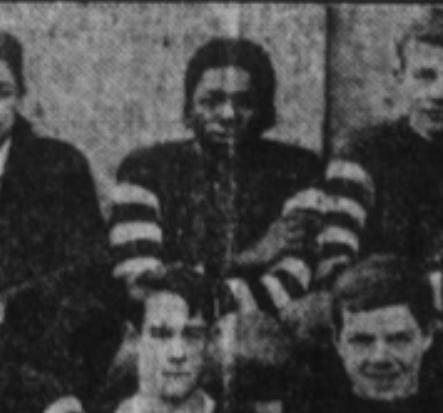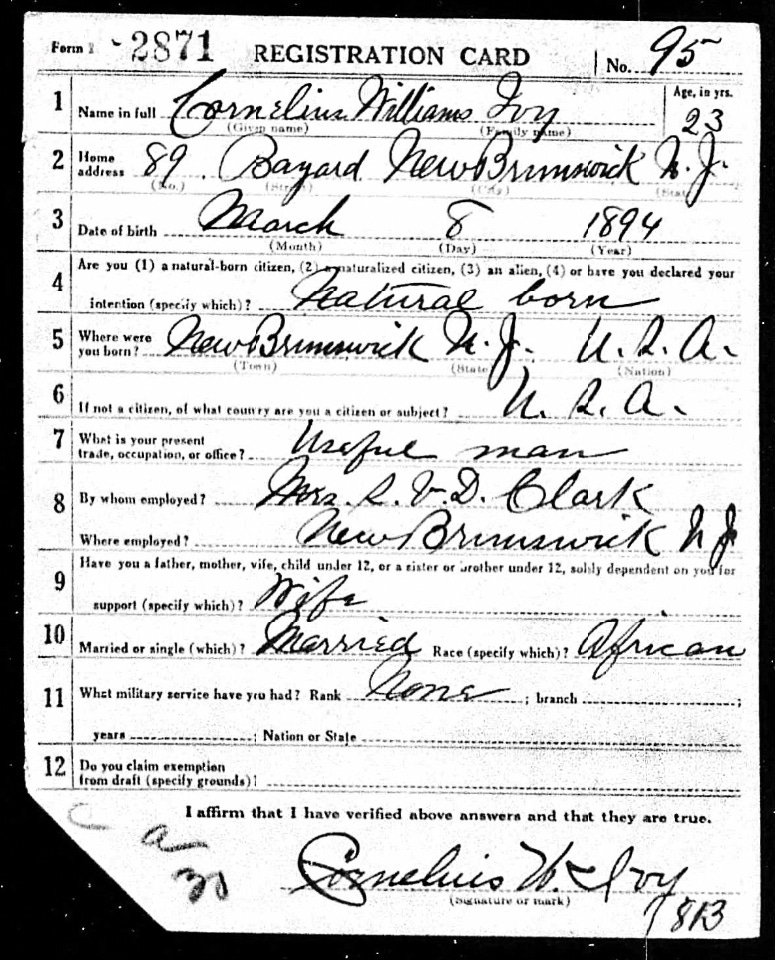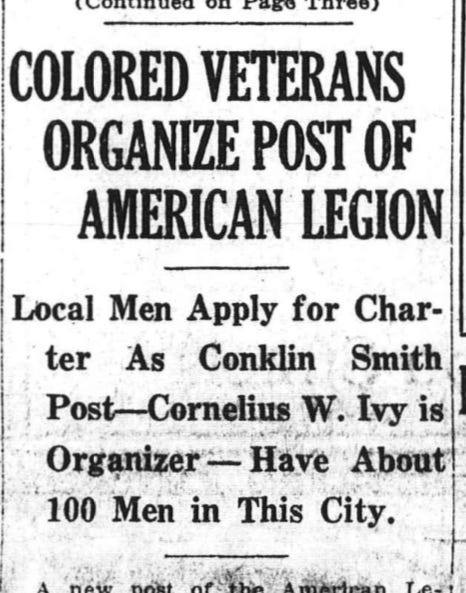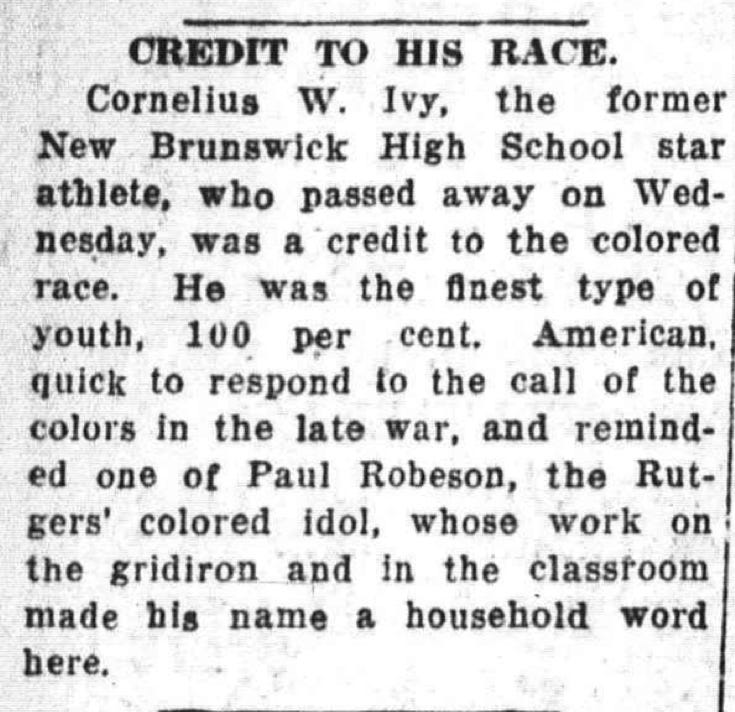Cornelius Ivy was like so many men of his generation; a remembered and respected member of the community that has faded from memory in the time since his passing. Still, his story is one worth remarking on. While his life was short, Cornelius Ivy made an impact on the community around him.
Cornelius William Ivy was born on March 8th, 1894 in New Brunswick. He would grow up there, attending the local public schools. By the time he reached High School he had developed into quite the athlete. He would play halfback for the New Brunswick High School football team, and would receive his varsity letter. Even outside of school he would attend local athletic competitions, favoring track events where he would compete as a sprinter. He would join the Manhattan Athletic Club for most of these events, an association he would continue with for much of his young adult life. His brother, Lloyd Ivy, would also join the Manhattan Athletic Club and would similarly participate in many races.
Cornelius would graduate from High School in 1913. He didn’t attend higher education immediately after High School, although a short personal article in the Social News section of The Daily Home News published in December of 1917 says he attended Wilson’s Business School, which evidently occurred sometime between his high school graduation and then.
During this time he would continue to compete with the Manhattan Athletic Club. In 1915 he would play with his brother on Manhattan AC’s basketball team as forwards, playing alongside Paul Robeson, who had just started attending Rutgers a few months prior.
The coming of World War I would change Ivy’s life forever. When America entered the conflict, a draft was quickly established, with the first draft call occurring on June 5, 1917. Over the course of the war 868 black men would be registered for the draft in Middlesex County. Ultimately, it is believed that 108 African-American men in Middlesex County would ultimately serve, with 60 of those having been from New Brunswick. Cornelius Ivy was one of these individuals.
Ivy was drafted later that year and was inducted into the army on November 19th at Camp Dix. Describing his occupation on his draft card as a “useful man,” he would prove himself to be just that. Ivy would be assigned to Battery A of the 350th Field Artillery Regiment. The 350th Field Artillery was part of the 92nd Division, an all-black infantry division. He began his service in the army as a private, but would be the recipient of multiple promotions. Within a month of entering service he was made a battery clerk with the rank of Corporal. He set sail for Europe on June 30, 1918. The USS President Grant, sailing out of Hoboken, would take Battery A of the 350th Field Artillery to the front lines of the conflict. By that point, Ivy had been promoted to Supply Sergeant.
In France, Ivy would serve with the Headquarters company of the regiment and would eventually see combat, becoming one of just 62 persons of color from Middlesex County to serve overseas. Of those 62, 55 served in combat units, of which Ivy was also included. The 92nd Division would be noted for its actions during the Meuse-Argonne Offensive. Despite his service with the Headquarters Company, which was mostly responsible for the administration of the unit, he would still see combat during the Meuse-Argonne campaign. During his service he would receive an ailment of some kind that would cause him health complications later in life.
The war would end on November 11, 1918, with troops returning home not long after. Ivy would set sail for home from Brest, France aboard the USS Maui on February 16, 1919, arriving in Hoboken later that month. By the end of his service he had been made a Regimental Sergeant Major, the highest non-commissioned rank available in the US Army at the time. He was discharged not long after, and by March was home to celebrate his birthday with many friends that were happy for his safe return home.
The time after the war was a time of great change for Ivy. In June of 1919 Ivy and his wife Ruth came into possession of property once belonging to Mr. And Mrs. Benjamin F. Woolset. That same month Ivy also joined the Royal Athletic Association and was put in charge of morale. Also that month the State Armory on Codwise Avenue in New Brunswick would hold a reception for soldiers of color. Ivy was part of the committee organizing the events and it would not be the last time he would serve his fellow veterans.
Ivy had returned from the war with leadership skills and respect among his fellow soldiers, with which he advocated on their behalf, becoming a fixture among black veterans in the city. In August of 1919 a drive was set up by the Charles Henry Post of the American Legion, which was the only post in the city at the time, to induct as many service members from the city as possible into the organization, and to fund the purchasing of a property for the local branch to be headquartered and for use as a civic center. Ivy would be part of the committee for the drive and would only get more involved with the American Legion from there.
In the beginning of September, Ivy would apply to the State Headquarters for a new American Legion post for his fellow soldiers of color in the city. It was the first of its kind in Middlesex County and was believed to have encouraged the opening of another branch for black veterans in Perth Amboy. The Daily Home News lauded Ivy’s efforts, commending him for his “excellent work on the committee in charge of the recent drive” and saying, “The colored soldiers showed such patriotism in the war that every effort is being made to keep up that spirit through the Legion.” After receiving its charter, the post held their first meeting on September 26, where Ivy was elected post commander. It was named the Conklin Smith Post in honor of Conklin Smith, a fellow soldier in the 350th who was well liked by his fellow soldiers and who unfortunately passed away during the war.
On the first anniversary of the Armistice the Conklin Smith Post would hold a dance and reception, the first of what was to become an annual event. In the year since the end of the war, Ivy had shown himself to be a skilled leader and was growing to become a distinguished member of the community. The post would continue under his leadership for sometime. It was unsurprising, given Ivy’s athletic prowess, that the post would be known for its athleticism when participating in intramural athletic events with other American Legion posts.
Beyond his work with the American Legion, Ivy was a member of the Superior Lodge of New Brunswick, among other fraternal and civic organizations. He also found work as a letter carrier, where he distinguished himself, becoming held in esteem by his fellow postal employees.
Unfortunately, Cornelius Ivy would pass away on March 16, 1921, having turned 27 only eight days prior. He predeceased his brother, his parents, and his wife. He and Ruth had no children. Ruth herself would never remarry and would be buried with him on April 17, 1982, having lived without him for 61 years. His death was attributed to ailments received during his military service, with his obituary describing him as having not felt well since returning home. He was well remembered by New Brunswick at the time. The Daily Home News compared him to Paul Robeson in an article and praised his patriotic service.
In addition to this praise, he was remembered by many of the organizations he was in. His co-workers, the fellow letter carriers of New Brunswick, also saw fit to honor him. The Friday following his death, after finishing their daily rounds, the postal workers marched from the post office to Ivy’s home to hold a short service in honor of their deceased comrade. Reverend J.W. Washington gave a sermon and finished the service with a prayer. Additionally, the entire assembled postal force sang “Nearer My God to Thee” and sent a floral piece in tribute to their colleague.
In 1932, more than a decade after his death, another American Legion post was chartered for African-American soldiers, which saw fit to bear his name. Clearly he was still held in esteem by his fellow community members even after his death. The post is gone today, with there being no record of the Cornelius Ivy Post of the American Legion after the 1940s. However, even though Cornelius Ivy has faded from public memory over the decades, it would be a disservice not to remember a man as accomplished as Mr. Ivy.
For all he accomplished in his short life, it would be unfair not to acknowledge the life and legacy of a man like Cornelius Ivy. He humbly described himself as a useful man on his draft card. His life demonstrated that this was certainly true, but in many ways he was more than that. He was a soldier, a leader, and an unsung part of New Brunswick history.
Sources:
Adams, John, and Joseph Foster. “A Tribute of Respect to Our Deceased Brother.” The Daily Home News. March 27, 1921, Sunday edition, sec. A Page Devoted to Articles of a Social Nature. http://newbrunswick.archivalweb.com/imageViewer.php?i=1637137&q=Cornelius%20ivy.
“American Legion Men Meet To-Night to Outline Work.” The Daily Home News. August 18, 1919, Monday Afternoon edition. http://newbrunswick.archivalweb.com/imageViewer.php?r=1447&in=3360&d=0.
“Athletic Association Meeting.” The Daily Home News. December 11, 1912, sec. Notes of the High School. http://newbrunswick.archivalweb.com/imageViewer.php?i=704212&q=Cornelius%20ivy.
“Colored Soldiers at State Armory To-Night.” The Daily Home News. June 24, 1919, Tuesday Afternoon edition. http://newbrunswick.archivalweb.com/imageViewer.php?i=1627554&q=Ivy&s=q%3DIvy%26p%3D2%26r%3D1447%26s%3Da%26o%3D15%26ps%3D15.
“Colored Veterans Organize Post of American Legion.” The Daily Home News. September 5, 1919, Friday Afternoon edition. http://newbrunswick.archivalweb.com/imageViewer.php?i=1628624&q=Cornelius%20iv.
“Colored Veterans to Hold an Armistice Dance and Reception.” The Daily Home News. November 1, 1919, Saturday Afternoon edition. http://newbrunswick.archivalweb.com/imageViewer.php?i=1629588&q=Ivy&s=q%3DIvy%26p%3D2%26r%3D1447%26s%3Da%26o%3D45%26ps%3D15.
“Cornelius W. Ivy, War Veteran, Dies at His Home Here.” The Daily Home News. March 17, 1921. http://newbrunswick.archivalweb.com/imageViewer.php?r=1449&in=1140&d=1.
“Credit to His Race.” The Daily Home News. March 18, 1921. http://newbrunswick.archivalweb.com/imageViewer.php?i=1636987&q=Cornelius%20iv.
“Crowd of 5,000 Sees Fine Performances at Monster Athletic Classic at Neilson Field.” The Daily Home News. July 6, 1915. http://newbrunswick.archivalweb.com/imageViewer.php?i=715635&q=Cornelius%20ivy.
“C.W. Ivy Honored By Friends on Birthday.” The Daily Home News. April 1, 1919. http://newbrunswick.archivalweb.com/imageViewer.php?i=1626250&q=Ivy&s=q%3DIvy%26p%3D2%26r%3D1447%26s%3Da.
“Elect Officers of Conklin Smith Post.” The Daily Home News. September 28, 1919, Sunday Morning edition. http://newbrunswick.archivalweb.com/imageViewer.php?i=1629014&q=Ivy&s=q%3DIvy%26p%3D2%26r%3D1447%26s%3Da%26o%3D30%26ps%3D15.
“High School Pupils to Enter Into Life.” The Daily Home News. June 07, 1913. http://newbrunswick.archivalweb.com/imageViewer.php?i=706577&q=Cornelius%20ivy.
“Ivy.” The Daily Home News. March 18, 1921, sec. Died. http://newbrunswick.archivalweb.com/imageViewer.php?i=1636977&q=Cornelius%20ivy.
“Kings of the Cinderpath, Including Metropolitan and National Champions Will be Seen in Action In Monster Athletic Meet on Monday Afternoon; Greatest Five Mile Race and Javelin Throwing Contest Put on in Year.” The Daily Home News. July 2, 1915, http://newbrunswick.archivalweb.com/imageViewer.php?r=715&in=2070&d=0.
“Letter Carriers Pay Tribute to Cornelius Ivy.” The Daily Home News. March 21, 1921, http://newbrunswick.archivalweb.com/imageViewer.php?i=1637055&q=Cornelius%20ivy.
Manhattans Will Play Two Games To-night.” The Daily Home News. December 03, 1915, http://newbrunswick.archivalweb.com/imageViewer.php?i=717393&q=Cornelius%20ivy.
O‘Neill, Harold, ed. “High School Eleven, Near End of Season, Has Fine Record.” The Daily Home News, November 15, 1912, sec. Timely Sporting News. http://newbrunswick.archivalweb.com/imageViewer.php?i=703875&q=Cornelius%20ivy&s=q%3DCornelius%2Bivy%26p%3D2%26r%3D0.
“Ralph Runyon of Penn State in the July 4th Athletic Meet.” The Daily Home News. June 23, 1916. http://newbrunswick.archivalweb.com/imageViewer.php?r=1463&in=2181&d=1&s=q%3DCornelius%2Bivy%26p%3D2%26r%3D0%26o%3D45%26ps%3D15.
“Royal A.A. Wants Games With Landing A.C. and Triangle A.C..” The Daily Home News. June 20, 1919. http://newbrunswick.archivalweb.com/imageViewer.php?r=1447&in=2478&d=1&s=q%3DIvy%26p%3D2%26r%3D1447%26s%3Da%26o%3D15%26ps%3D15.
The Daily Home News. December 5, 1917, sec. Personals. http://newbrunswick.archivalweb.com/imageViewer.php?i=1694356&q=Cornelius%20iv.
"US, Army WWI Transport Service, Passenger Lists, 1917-1938," digital images, Fold3.com, Page 542; citing List of Outgoing Passengers 1917-1938: NARA catalog ID 6234465.
"US, Army WWI Transport Service, Passenger Lists, 1917-1938," digital images, Fold3.com, Page 472; citing List of Incoming Passengers 1917-1938; NARA catalog ID 6234467.
Walling, Richard Sears. They Also Served: African American Men of Middlesex County, NJ In World War One. Edison, NJ: NAACP-MEAB, 2019.
"World War I Draft Registration Cards, 1917-1918," digital images, Fold3.com, Cornelius William Ivy, serial no. 2871, order no. 95, Precinct 14, New Brunswick, Middlesex County, New Jersey; citing World War I Selective Service System Draft Registration Cards, NARA microfilm publication M1509; NARA catalog ID 572850.








